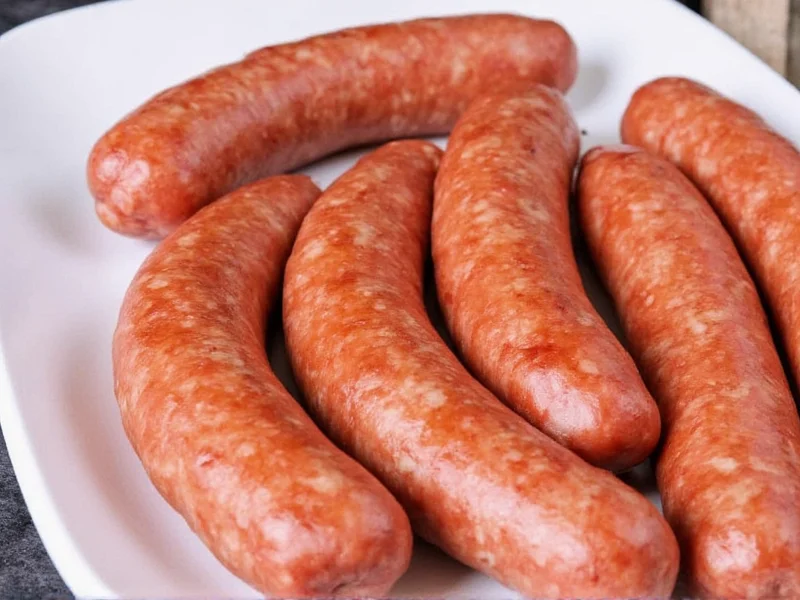Understanding proper food storage is essential for preventing foodborne illness while minimizing waste. When stored correctly, cooked sausage provides a convenient meal option that maintains both safety and quality for several days. This guide outlines evidence-based storage recommendations from food safety authorities to help you make informed decisions about your leftovers.
Factors Affecting Cooked Sausage Shelf Life
The 3-4 day guideline represents the maximum safe storage time under ideal conditions. Several factors can shorten this window:
- Type of sausage - Fresh sausages with higher moisture content spoil faster than smoked varieties
- Storage temperature - Refrigerators operating above 40°F accelerate bacterial growth
- Initial cooking temperature - Sausage not cooked to proper internal temperature (160°F) may contain surviving pathogens
- Cross-contamination - Contact with raw meats or unclean surfaces introduces bacteria
- Storage container - Non-airtight containers allow moisture loss and bacterial exposure
Proper Storage Techniques for Maximum Freshness
Follow these evidence-based methods to maximize both safety and quality of your cooked sausage leftovers:
- Cool quickly - Divide large portions into smaller containers to facilitate rapid cooling
- Use appropriate containers - Glass or BPA-free plastic containers with tight-fitting lids work best
- Maintain proper temperature - Verify your refrigerator consistently stays at 40°F or below using a thermometer
- Store in the coldest zone - Place containers on lower shelves toward the back, not in the door
- Label with dates - Mark containers with preparation date to track freshness
| Storage Method | Optimal Temperature | Maximum Safe Duration |
|---|---|---|
| Refrigerator (properly stored) | 40°F (4°C) or below | 3-4 days |
| Freezer (airtight container) | 0°F (-18°C) | 2-3 months |
| Room temperature | Above 40°F (4°C) | 2 hours maximum |
Recognizing Spoiled Cooked Sausage
Even within the recommended timeframe, spoilage can occur if storage conditions weren't ideal. Check for these warning signs before consuming leftovers:
- Visual changes - Grayish color, mold growth, or slimy film on surface
- Odor changes - Sour, rancid, or unpleasant smells (fresh cooked sausage should have a pleasant meaty aroma)
- Texture changes - Excessive stickiness or sliminess when touched
- Unusual taste - Never taste questionable food to check safety
When in doubt, throw it out. Consuming spoiled sausage can cause foodborne illnesses with symptoms including nausea, vomiting, diarrhea, and abdominal cramps.
Freezing Cooked Sausage for Extended Storage
For longer preservation beyond the 3-4 day refrigeration window, freezing provides a safe alternative:
- Portion sausage into meal-sized servings before freezing
- Use freezer-safe containers or heavy-duty freezer bags
- Remove as much air as possible from packaging to prevent freezer burn
- Label packages with contents and date
- Thaw frozen sausage in the refrigerator, not at room temperature
Properly frozen cooked sausage maintains safety indefinitely, though quality gradually declines after 2-3 months. For best results, consume frozen sausage within this timeframe.
Food Safety Considerations for Vulnerable Populations
Certain groups face higher risks from foodborne pathogens. If preparing meals for infants, elderly individuals, pregnant women, or immunocompromised persons, consider reducing the storage window to 2-3 days and exercising extra caution when evaluating freshness.
Practical Tips for Managing Cooked Sausage Leftovers
Implement these strategies to maximize both safety and enjoyment of your cooked sausage:
- Reheat to 165°F internal temperature using a food thermometer
- Add moisture when reheating to prevent drying (a splash of water or broth)
- Store sausage separate from other foods to prevent cross-contamination
- Clean containers thoroughly between uses
- When traveling, use insulated containers with ice packs to maintain safe temperatures
Frequently Asked Questions
Can you eat cooked sausage after 5 days in the refrigerator?
No, cooked sausage should not be consumed after 5 days in the refrigerator. The USDA recommends discarding cooked sausage after 3-4 days of refrigeration, even if it appears normal. Bacterial growth may occur without visible signs, potentially causing foodborne illness.
How can you tell if cooked sausage has gone bad in the fridge?
Signs of spoiled cooked sausage include a sour or unpleasant odor, grayish color, slimy texture, visible mold growth, or an off taste. If you notice any of these indicators, discard the sausage immediately. When in doubt about freshness, it's safer to discard questionable leftovers.
Does the type of sausage affect how long it lasts in the refrigerator?
Yes, different sausage varieties have varying shelf lives. Smoked sausages generally last slightly longer than fresh varieties due to preservation methods. However, the USDA standard recommendation of 3-4 days applies to all cooked sausages when properly refrigerated. Always follow this guideline regardless of sausage type for maximum safety.
Can you freeze cooked sausage to extend its shelf life?
Yes, freezing cooked sausage extends its safe storage period significantly. When properly packaged in airtight, freezer-safe containers, cooked sausage maintains quality for 2-3 months in the freezer at 0°F (-18°C). While frozen sausage remains safe indefinitely, quality gradually declines after the recommended timeframe.
What's the proper way to reheat cooked sausage from the refrigerator?
Reheat cooked sausage to an internal temperature of 165°F (74°C) using a food thermometer. Add a small amount of liquid to prevent drying, and heat gently on medium-low settings. Microwave reheating works well when covered with a damp paper towel. Always reheat only the portion you plan to consume immediately.











 浙公网安备
33010002000092号
浙公网安备
33010002000092号 浙B2-20120091-4
浙B2-20120091-4